I1 : Formation and early evolution of Planetary systems
Project merged with the new interface project I6 : From dust to planets
-
The major planets in our Solar System were known to ancient civilization thousands of years ago, and the principles by which they moved in the sky have been known for several hundred years. Yet, despite decades of modern research, telescopic observations, and up-close visits from spacecraft, the manner by which our Solar System formed, and the manner by which the modern planets evolved from stardust, are still poorly understood. In addition to resolving frustratingly simple questions about our Solar System, we are now confronted with the existence of other planetary systems surrounding other stars, many of which are quite different from ours.
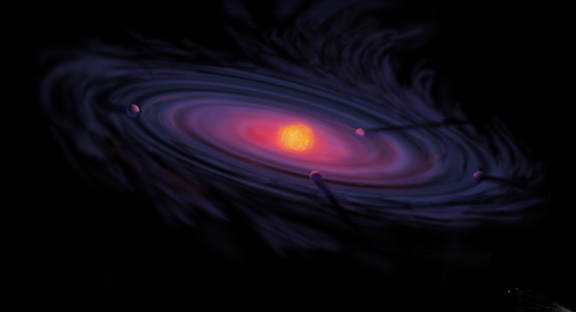
Today, it is generally thought that planets formed by the hierarchical accretion of larger and larger sized bodies, from dust to planets. The accumulation of gas by gravitational instabilities, collisions between solid objects, and orbital resonances are all known to play important roles in the early evolution of our Solar System. The earliest of these processes are not operating today, but their consequences sould be observable in other young planetary systems using high precision instruments, such as those that will be flown on the James Webb Space Telescope. Even the most precise observations from space will not be able to resolve all of our questions, requiring that such observations be compared and coupled with results from sophisticated numerical simulations.
In the first million year of our Solar System, grains coagulated and gas condensed to form the first solids. Today, the signature of these fundamental primordial processes are coded in the structure and chemical composition of primitive meteorites. We think that the protoplanetary disk was initially hot in the region of the terrestrial planets, heated by both the protosun radiation and the disk’s turbulence. However, the thermodynamical conditions in which the planets formed are still poorly understood. Was the protosun more luminous than today? Was there water in the region of the terrestrial planets? Where did the first minerals form and how were they transported throughout the Solar System? To answer these questions numerical modeling of the protoplanetary nebula are required, in combination with measurements obtained in laboratory experiments. In addition, the direct observation of distant protoplanetary disks and exoplanets will give critical constraines on the early periods of planetary evolution.
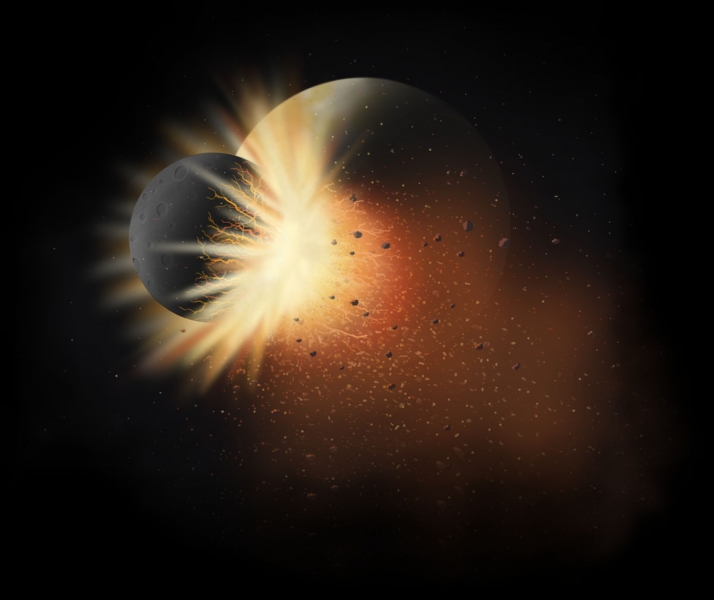 The late stages of planetary accretion were dominated by highly energetic giant collisions. The Earth-Moon system is thought to have originated by the collision of two objects, with the impactor being perhaps as large as Mars, putting large quantities of material into orbit about the Earth that eventually accreted to form our Moon. Since the internal geologic activity of the Moon has been fairly quiescent since its formation, the Moon is an ideal place to study early Solar System processes. For example, did the energy liberated by this collision melt large portions of the two bodies, forming “magma oceans” hundred of kilometers deep? And why is the composition of the Moon nearly identical for some elements, but not for others? Answers to these questions will not only inform us of how our planet formed, but will also provide important clues for understanding the general processes of satellite formation.
The late stages of planetary accretion were dominated by highly energetic giant collisions. The Earth-Moon system is thought to have originated by the collision of two objects, with the impactor being perhaps as large as Mars, putting large quantities of material into orbit about the Earth that eventually accreted to form our Moon. Since the internal geologic activity of the Moon has been fairly quiescent since its formation, the Moon is an ideal place to study early Solar System processes. For example, did the energy liberated by this collision melt large portions of the two bodies, forming “magma oceans” hundred of kilometers deep? And why is the composition of the Moon nearly identical for some elements, but not for others? Answers to these questions will not only inform us of how our planet formed, but will also provide important clues for understanding the general processes of satellite formation.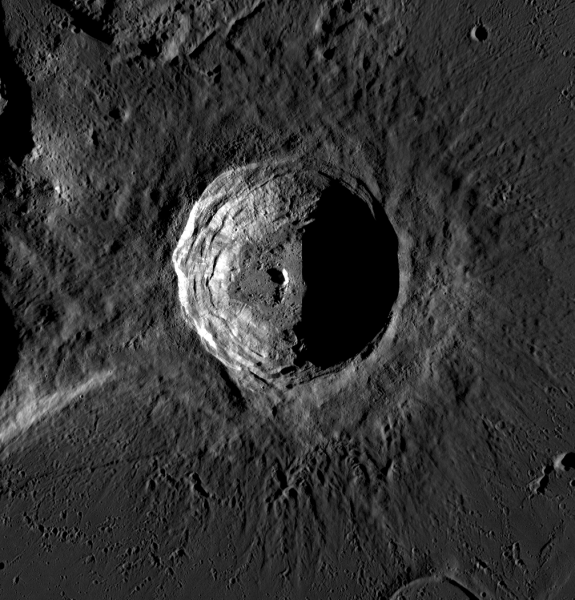 In addition to using the Moon to understand late stage planetary formation processes, the subdued internal geologic activity of this body makes it an idea recorder of the near-Earth impact environment. It is through the dating of Apollo samples associated with giant impact basins that the concept of a “late heavy bombardement” was born (i.e., a spike in the cratering rate a few hundred millions of years after the formation of our Solar System). The Moon has also been a recorder of the impact cratering rate for younger times as well, and likely holds import keys regarding collisional processes and resonances that are acting in the asteroid belt. Given that the Moon does not have weather as on Earth, many of its impact craters are in near-pristine form, and study by orbital and in situ measurements will inform us of how impact events affected the other planets.
In addition to using the Moon to understand late stage planetary formation processes, the subdued internal geologic activity of this body makes it an idea recorder of the near-Earth impact environment. It is through the dating of Apollo samples associated with giant impact basins that the concept of a “late heavy bombardement” was born (i.e., a spike in the cratering rate a few hundred millions of years after the formation of our Solar System). The Moon has also been a recorder of the impact cratering rate for younger times as well, and likely holds import keys regarding collisional processes and resonances that are acting in the asteroid belt. Given that the Moon does not have weather as on Earth, many of its impact craters are in near-pristine form, and study by orbital and in situ measurements will inform us of how impact events affected the other planets.Progress on all of these questions will be made from a multi-disciplinary approach involving researchers at the laboratory AIM (Astrophysique Interaction Multi-échelle) and the Institut de Physique du Globe de Paris (IPGP). Our studies will investigate the formation of the first solids in planetary systems using both numerical simulations and laboratory experiments. We will investigate the origin of planetary systems through the direct detection and characterization of exoplanets, and compare these observations to numerical simulations. Finally, we will investigate the origin of the Moon, its early evolution, and the process of impact cratering in our Solar System.
-
Permanent personnel

Sébastien Charnoz Astrophysique Interactions Mulit-échelles (AIM)
Rings, Disks and PlanetsUniv Paris Diderot
35, rue Hélène Brion
Lamarck A, Bureau 719
sebastien.charnoz@cea.fr
Pierre-Olivier Lagage Astrophysique Interactions Mulit-échelles (AIM)
CEA Saclay
Bat. 709
Gif-sur-Yvette
pierre-olivier.lagage@cea.fr
Philippe Lognonné Institut de Physique du Globe de Paris (IPGP)
Planetary and Space SciencesUniv Paris Diderot
35 rue Hélène Brion
Lamarck A, Bureau 707
lognonne@ipgp.fr
Chloé Michaut Institut de Physique du Globe de Paris (IPGP)
Planetary and Space SciencesUniv Paris Diderot
35, rue Hélène Brion
Lamarck A, Bureau 717
michaut@ipgp.fr
Manuel Moreira Institut de Physique du Globe de Paris (IPGP)
Geochemistry and CosmochemistryIPGP
1, rue Jussieu
Bureau 561
moreira@ipgp.fr
Mark A. Wieczorek Institut de Physique du Globe de Paris (IPGP)
Planetary and Space SciencesUniv Paris Diderot
35, rue Hélène Brion
Lamarck A, Bureau 722
wieczor@ipgp.frPost docs and Ph.D. students

Katarina Miljković (post doc) Institut de Physique du Globe de Paris
Planetary and Space SciencesUniv Paris Diderot
35 rue Hélène Brion
Lamarck A, bureau 713
miljkovic@ipgp.fr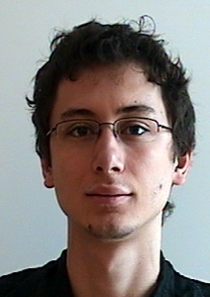
Matthieu Laneuville (Ph.D. student) Institut de Physique du Globe de Paris
Planetary and Space SciencesUniv Paris Diderot
35 rue Hélène Brion
Lamarck A, bureau 724
laneuville@ipgp.fr
Clément Thorey (Ph.D. student) Institut de Physique du Globe de Paris
Planetary and Space Sciences -
Tracking the Earliest Phase of Planetary Formation: The first solids
 The laboratory AIM (Astrophysique Interaction Multi-échelle) is involved in several infrared programs (such as VLT/VISIR) and will have guaranteed time on the spectro-imager and coronograph (MIRI) on the future James Webb Space Telescope (JWST). Images of protoplanetary disks surrounding young stars (<107 years) will reveal the earliest phases of planetary formation. The spatial and size distributions of dust (the first solids) are affected by on-going planet formation, and from such observations key questions will be able to be addressed about the evolution of the disk properties and how the depend upon stellar age and metallicity. Planets embedded in their disks will be directly imaged and their interactions will be studied directly.
The laboratory AIM (Astrophysique Interaction Multi-échelle) is involved in several infrared programs (such as VLT/VISIR) and will have guaranteed time on the spectro-imager and coronograph (MIRI) on the future James Webb Space Telescope (JWST). Images of protoplanetary disks surrounding young stars (<107 years) will reveal the earliest phases of planetary formation. The spatial and size distributions of dust (the first solids) are affected by on-going planet formation, and from such observations key questions will be able to be addressed about the evolution of the disk properties and how the depend upon stellar age and metallicity. Planets embedded in their disks will be directly imaged and their interactions will be studied directly.Closer to home, the former protoplanetary disk of our Solar System has left a wealth of fossil information buried in the solid materials that make up our planetary system. Laboratory isotopic measurements (with mass spectrometers and ion probes) in meteorites, comets and other planetary materials give invaluable chronological constraints on the formation of the first solids (CAI, Chondrules). The use of short-lived radioactive elements allows a very fine chronology of these objects (e.g. 26Al). Chronology markers can also constrain the importance of the reprocessing of early planetary embryos in the formation of late-stage and larger embryos. How dust was processed during the first million years is unclear. Solar wind and irradiation may have modified the chemistry and the isotopic signatures of the pre-solar grains and the solids formed in-situ. Isotopic measurements (oxygen, rare gases, short-lived radiogenic isotopes) may also characterize the different parent bodies from which the terrestrial planets were assembled and provide clues to the origin of their volatiles. Coupling these results with numerical simulations of planetary formation will be seminal to better understanding the evolution of planetary systems.
The laboratory AIM is leading the development of a large modeling program focusing on 1) the transport of the first solids in the protoplanetary disk and their incorporation into embryos, including turbulent dynamics, radiative effects, and planet-disk interactions. Chemistry will be included into N-body codes of dust transport. We will interpret the JWST imaging data in term of 3D disk structures. We will interpret isotopic abundances in meteorites to check if transport is dynamically possible from the different reservoirs (comet region, solar region, extrasolar source, disk photosphere) to the terrestrial planet zone and if the Earth has accreted from local embryos or from bodies spread across the disk.
Tracking Exoplanets
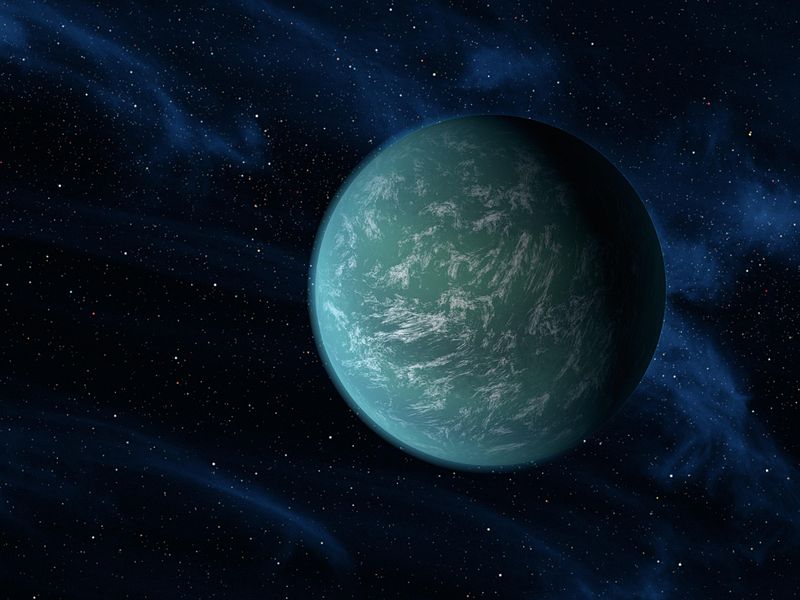 The detection and direct imaging of exoplanets with the James Webb Space Telescope will represent a breakthrough in understanding planetary formation. Super-earths will be detected during their transits, providing the size and orbit of the planet as well as direct access to the exoplanet’s atmosphere, or surface, through spectroscopic measurements. The surface of these planets will be characterized and will yield strong constraints on their formation process. Further from the star (>10 AU), giant–gaseous exoplanets and the surround stellar disk are in the reach of direct imaging as well. These observations will provide direct data on the interaction of young planets with their disk. If the system is young (< 10 My) this will constrain the migration process, as well as the possibility for the planet to form satellites. If the system is older (>10 My), the disk may be similar to our Kuiper belt, and models of belt evolution can be tested and compared to our Solar System.
The detection and direct imaging of exoplanets with the James Webb Space Telescope will represent a breakthrough in understanding planetary formation. Super-earths will be detected during their transits, providing the size and orbit of the planet as well as direct access to the exoplanet’s atmosphere, or surface, through spectroscopic measurements. The surface of these planets will be characterized and will yield strong constraints on their formation process. Further from the star (>10 AU), giant–gaseous exoplanets and the surround stellar disk are in the reach of direct imaging as well. These observations will provide direct data on the interaction of young planets with their disk. If the system is young (< 10 My) this will constrain the migration process, as well as the possibility for the planet to form satellites. If the system is older (>10 My), the disk may be similar to our Kuiper belt, and models of belt evolution can be tested and compared to our Solar System.A large program of numerical simulation will be led, principally in the form of N-body codes, to simulate the assembly of planets from embryos and to track basic chemical composition, which is relevant for the mid and late stages of planet formation. Interactions with the surrounding disk can be included in the form of test particle algorithms for the debris disk or in the form of an Eulerian gaseous disk. In the latter case an effort will be focused on modelling properly radiative effects, in order to go beyond the local-isothermal disk model.
Origin and Early Evolution of the Moon
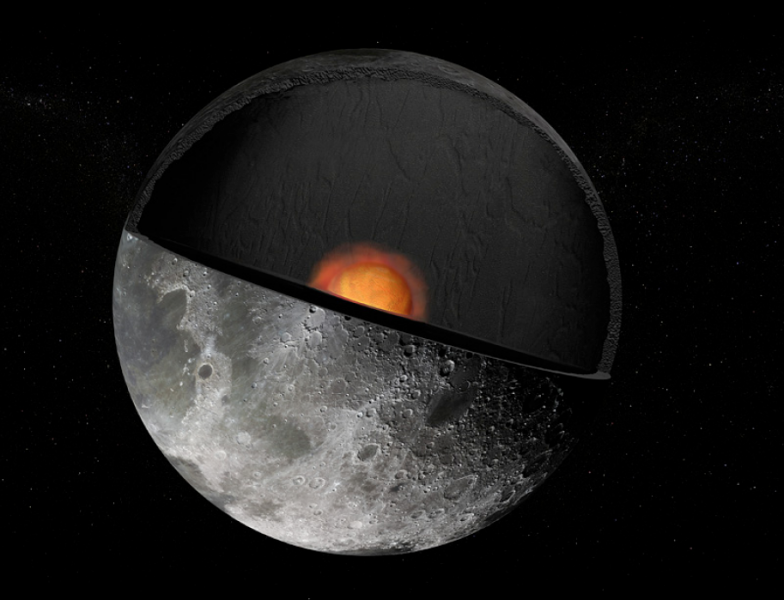 The Earth-Moon system is unique among the terrestrial planets and provides invaluable clues to the origin and early evolution of our Solar System. Analyses of Lunar data not only gave rise to the model that the Earth and Moon formed together during an impact between the proto-Earth and a large planetessimal, but also that terrestrial planets may have formed with globe encircling magma oceans. It is data from the Moon that have quantified the consequences of impact events in early Solar System history, gave rise to a dating technique based on counting craters, and spawned the idea that a “late heavy bombardment” of asteroids and comets may have affected catastrophically all the terrestrial planets about 4 billion years ago.
The Earth-Moon system is unique among the terrestrial planets and provides invaluable clues to the origin and early evolution of our Solar System. Analyses of Lunar data not only gave rise to the model that the Earth and Moon formed together during an impact between the proto-Earth and a large planetessimal, but also that terrestrial planets may have formed with globe encircling magma oceans. It is data from the Moon that have quantified the consequences of impact events in early Solar System history, gave rise to a dating technique based on counting craters, and spawned the idea that a “late heavy bombardment” of asteroids and comets may have affected catastrophically all the terrestrial planets about 4 billion years ago.The Institut de Physique du Globe (IPGP) has an internationally recognized expertise in planetary geophysics and is actively involved in several past, present, and upcoming lunar missions. One mission, GRAIL (Gravity Recovery and Interior Laboratory) has been making high resolution measurements of the Moon’s gravity field, which is providing important clues concerning the interior structure and impact bombardment history of this object. Other missions that are actively being studied include NASA’s sample-return mission MoonRise, Japan’s geophysical station SELENE-2. Furthermore, a mission to place two landers on the farside of the Moon (Farside Explorer) for the purposes of geophysics, radio astronomy, geochemistry, and impact bombardment, is actively being developed by our group.
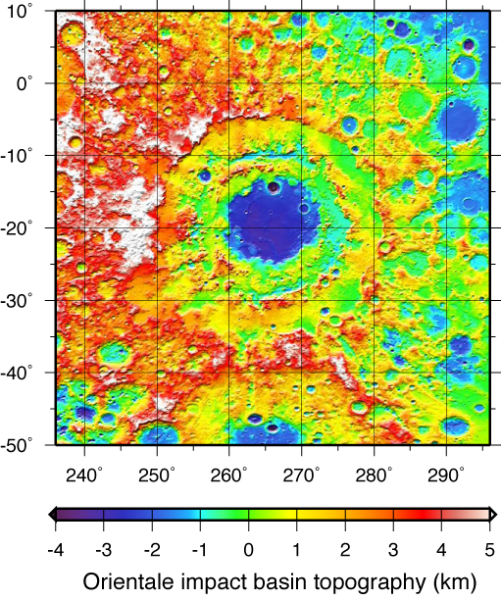 One long-term IPGP research activity has been the use of Apollo seismic data to investigate the structure and composition of the lunar crust, mantle, and core. These studies place important constraints on the Earth-Moon forming impact, primary differentiation, core formation, magma-ocean crystallization, and the operation of planetary dynamos. Another long-term activity has been on using orbital gravity, topography, and remote sensing data to investigate large impact structures and to constrain the origin and evolution of the crust. More recently, our lunar activities have expanded to include magma transport and eruptive processes, crustal magnetism, and asymmetries in the lunar impact-cratering rate. The laboratory AIM provides a complimentary expertise in the formation of planetary satellites.
One long-term IPGP research activity has been the use of Apollo seismic data to investigate the structure and composition of the lunar crust, mantle, and core. These studies place important constraints on the Earth-Moon forming impact, primary differentiation, core formation, magma-ocean crystallization, and the operation of planetary dynamos. Another long-term activity has been on using orbital gravity, topography, and remote sensing data to investigate large impact structures and to constrain the origin and evolution of the crust. More recently, our lunar activities have expanded to include magma transport and eruptive processes, crustal magnetism, and asymmetries in the lunar impact-cratering rate. The laboratory AIM provides a complimentary expertise in the formation of planetary satellites.This research theme has many goals, including to further understand the structure and composition of the Moon’s interior, to better constrain the giant-impact event that formed the Earth-Moon system, to decipher the thermal and magmatic evolution of the Moon, to better constrain the impact history of the Moon and terrestrial planets, and to improve the crater chronology dating technique. We plan to not only analyze data from past and upcoming space missions, but in collaboration with IMCCE, Uranoscope, and the Observatoire Midi- Pyrénées, IPGP will also be developing a world-wide observational network for detecting flashes from meteor impacts on the Moon. In addition to our studies related to the Earth-Moon system, our results will prove critical for understanding the processes that have affected the other terrestrial planets and icy satellites of the outer solar system.
-
2013
Asymmetric distribution of lunar impact basins caused by variations in target properties
Miljković, K., M. A. Wieczorek, G. S. Collins, M. Laneuville, G. A. Neumann, H. J. Melosh, S. C. Solomon, R. J. Phillips, D. E. Smith, M. T. Zuber
Science, 342, 724-726, doi:10.1126/science.1243224.Asymmetric thermal evolution of the Moon
Laneuville, M., M. A. Wieczorek, D. Breuer, and N. Tosi
J. Geophys. Res. Planets, 118, 1435-1452, doi:10.1002/jgre.20103.Morphology and population of binary asteroid impact craters
Miljković, K., G. S. Collins, S. Mannick, P. Bland
Earth Planet. Sci. Lett., 363, 121-132, 2013, doi: 10.1016/j.epsl.2012.12.033.The Crust of the Moon as Seen by GRAIL
Wieczorek, M. A., G. A. Neumann, F. Nimmo, W. S. Kiefer, G. J. Taylor, H. J. Melosh, R. J. Phillips, S. C. Solomon, J. C. Andrews-Hanna, S. W. Asmar, A. S. Konopliv, F. G. Lemoine, D. E. Smith, M. M. Watkins, J. G. Williams, M. T. Zuber
Science, 6120, 671-675, doi: 10.1126/science.1231530.2012
Formation of Regular Satellites from Ancient Massive Rings in the Solar System
Crida, A., and S. Charnoz
Science, 338, 1196-1199, 2012, doi: 10.1126/science.1226477.
